
Holcus is a genus of African and Eurasian plants in the oat tribe within the grass family.

Spartina anglica is a species of cordgrass that originated in southern England in about 1870 and is a neonative species endemic to Britain. It was reclassified as Sporobolus anglicus after a taxonomic revision in 2014, but Spartina anglica is still in common usage. It is an allotetraploid species derived from the hybrid Spartina × townsendii, which arose when the European native cordgrass Spartina maritima hybridised with the introduced American Spartina alterniflora.

Ehrharta is a genus of plants in the grass family.

Sporobolus heterolepis, commonly known as prairie dropseed, is a species of prairie grass native to the tallgrass and mixed grass prairies of central North America from Texas to southern Canada. It is also found further east, to the Atlantic coast of the United States and Canada, but is much less common beyond the Great Plains and is restricted to specialized habitats. It is found in 27 states and four Canadian provinces.

Sporobolus is a nearly cosmopolitan genus of plants in the grass family. The name Sporobolus means "seed-thrower", and is derived from Ancient Greek word σπόρος (spóros), meaning "seed", and the root of βάλλειν (bállein) "to throw", referring to the dispersion of seeds. Members of the genus are usually called dropseeds or sacaton grasses. They are typical prairie and savanna plants, occurring in other types of open habitat in warmer climates. At least one species is threatened with extinction, and another is extinct.
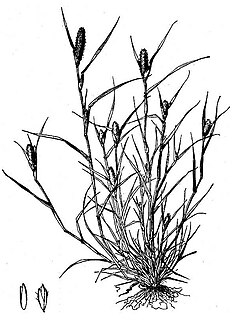
Crypsis is an African and Eurasian plant in the grass family sometimes referred to as pricklegrass.
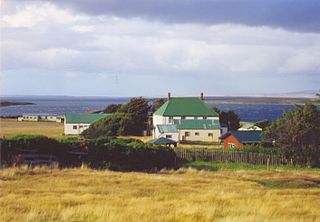
Tussock grasses or bunch grasses are a group of grass species in the family Poaceae. They usually grow as singular plants in clumps, tufts, hummocks, or bunches, rather than forming a sod or lawn, in meadows, grasslands, and prairies. As perennial plants, most species live more than one season. Tussock grasses are often found as forage in pastures and ornamental grasses in gardens.

Sporobolus virginicus, known by numerous common names including seashore dropseed, marine couch, sand couch, salt couch grass, saltwater couch, coastal rat-tail grass, and nioaka, is a species of grass with a wide distribution.
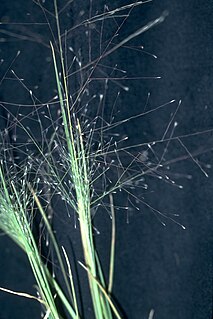
Muhlenbergia asperifolia is a species of grass known by the common names alkali muhly and scratchgrass. It is native to much of North America, including most of southern Canada, most of the continental United States except for the southeastern region, and parts of northern Mexico. It is also known from South America.

Sporobolus airoides is a species of grass known by the common name alkali sacaton. It is native to western North America, including the Western United States west of the Mississippi River, British Columbia and Alberta in Canada, and northern and central Mexico. It grows in many types of habitat, often in alkali soils, such as in California desert regions.

Sporobolus cryptandrus is a species of grass known by the common name sand dropseed. It is native to North America, where it is widespread in southern Canada, most of the United States, and northern Mexico.

Sporobolus indicus is a species of grass known by the common name smut grass.

Sporobolus vaginiflorus is a species of grass known by the common names poverty grass, poverty dropseed, and sheathed dropseed.

Sporobolus spicatus, also known as salt grass, is a halophyte.

Acacia argyrodendron, known colloquially as black gidyea or blackwood, is a species of Acacia native to Australia. Czech botanist Karel Domin described this species in 1926 and it still bears its original name. Domin reported collecting the type specimen from somewhere between Camooweal and Burketown in northwestern Queensland, though it is more likely to have been northeast of Aramac.

Sporobolus junceus is a species of grass known by the common name pineywoods dropseed. It is native to the southern United States.
Sporobolus wrightii is a species of grass known by the common names big sacaton and giant sacaton. It is native to the western United States and northern and central Mexico.
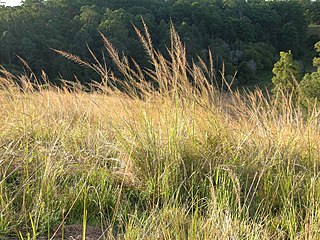
Sporobolus pyramidalis, commonly known as giant rat's tail grass, is a species of grass native to Africa and Yemen. It has become a weed in eastern Australia.
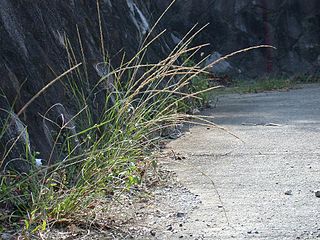
Sporobolus fertilis is a species of grass native to the Himalayas, India, Sri Lanka, Burma, Thailand, China, Japan, and Malaysia. It is an invasive species in Australia, where it is known as giant parramatta grass. This plant first appeared in scientific literature as Agrostis fertilis in the Synopsis Plantarum Glumacearum of 1854, published by the German botanist Ernst Gottlieb von Steudel.


















